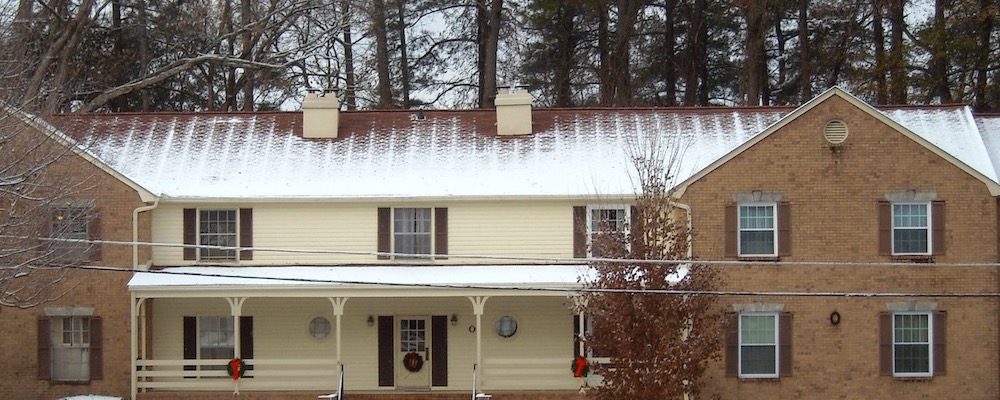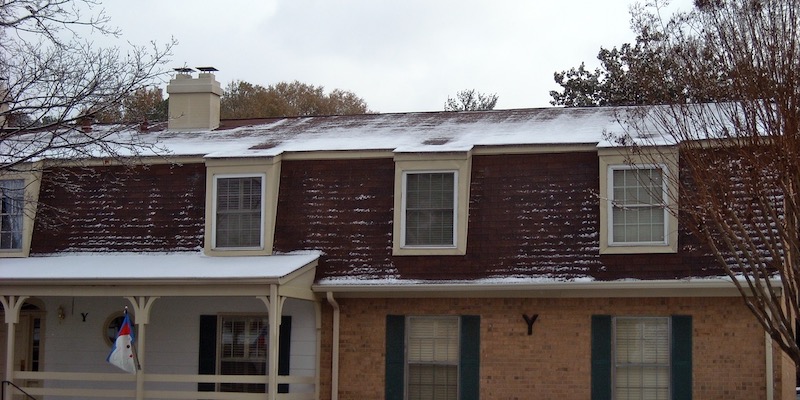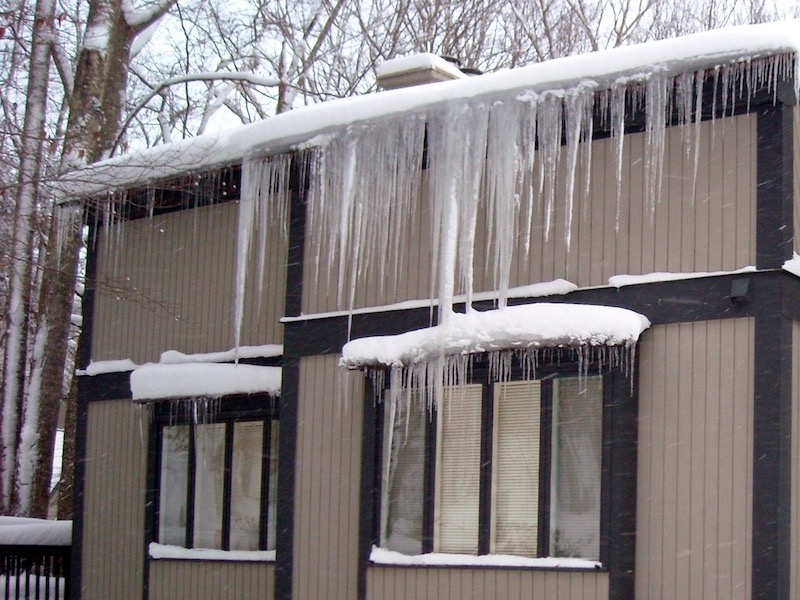Snow on the Roof – The Poor Man’s Infrared Camera

We got a couple inches of snow here in Atlanta over the holidays. That always offers a great look at heat loss through the ceiling, so I love to get outside and take pictures. After the snow has been on the rooftops for a day or so, the quality of the building enclosure is easy to see.
In the lead photo above, you can see what happened after that snow had been on the roof for only 12 hours. Near the ridge, the snow had all melted. Farther down, you can see the outline of where the rafters are. At the eave, the snow is as thick as it had been all over the roof when the snow first came down. The photo below shows another building in the community with the same problem.

These buildings are in the condo complex where I live, and there’s a lot of heat loss to the attic. The building envelope is supposed to keep the heat in the house. If, however, there are air leaks through the ceiling or the insulation is inadequate or both, the home loses heat to the attic. That heat then melts the snow on the roof.
By contrast, the building below, also in our community, shows little evidence of melting snow. This is what all the roofs in the community should look like.

One serious problem that can occur in areas where you have significant accumulations of snow on the roof is ice dams and icicles. When that snow on the roof melts, it runs down to the eave as liquid water. At the eave, it’s not being heated from below anymore, so it refreezes, as shown below. You can see the ice dam at the roof’s edge in the photo below, with huge icicles hanging below it.

Who needs an infrared camera when you’ve got snow!
Allison A. Bailes III, PhD is a speaker, writer, building science consultant, and the founder of Energy Vanguard in Decatur, Georgia. He has a doctorate in physics and writes the Energy Vanguard Blog. He is also writing a book on building science. You can follow him on Twitter at @EnergyVanguard.
Related Articles
A Tale of Two Roofs – Frost, Snow, and Attic Heat Loss
When It Comes to Ice Dams, You CAN Fix Stupid!
Be a Controlling Building Enclosure Control Freak with Control Layers
11 Building Science Secrets Every Home Builder & Remodeler Should Know
Comments are closed
This Post Has 14 Comments
Comments are closed.

Love reading your stuff we
Love reading your stuff we noticed that in our neighborhood alot, infact one of the neighbors we are thinking about running a duct from their attic to heat our home.
Good one, Buddy! Sad but true
Good one, Buddy! Sad but true, but you probably could pull usable heat out of some attics, even on really cold days in winter.
That is quite interesting. I
That is quite interesting. I never knew that. Now, of course, I’ll be obsessed with checking roofs for hot spots. Well, except for the Santa Barbara, lack of snow thing! But I really never realized that. Now I’ll mention it when near snow and sound very smart!
Alexandra: Yes, it IS
Alexandra: Yes, it IS interesting. You can see it to a lesser extent with frost, too. Do you ever get frost in Santa Barbara? And if not, you probably can’t grow very tasty collard greens there, can you?
A number of years ago, I
A number of years ago, I showed a photo of my previous home to a friend who is in the business. His immediate reaction was that the house must be very efficient. I asked how he could tell, just from a photo. He said because the snow on the roof is very thick and even.
http://tinyurl.com/38mcey3
Great article, Allison! As
Great article, Allison! As usual, concise, clear, and packs a lot of useful information. It’s always interesting to me how much of the same information we use high-tech gear to detect can often be discerned via simple observation under the right conditions. Oh, and my New England winters actually produce some pretty tasty collards, too!
~John
not to brag, but we got some
not to brag, but we got some of that snow here in eastern NC as well, and it lasted uniformly on my roof longer than any other in my neighborhood. ‘Sealing the ceiling’ really works! (Of course, it helps that mine is the only one facing north at the end of a cul-de-sac…)
David, that is indeed
David, that is indeed impressive. Is that your house in Charlotte, and was it right around Groundhog Day 2004? If so, we got a little bit of that same snow here in Atlanta, and I was living in the house that I’d just built. It, too, kept snow on the roof longer than any other house around.
Sometimes lots of uniform snow on the roof isn’t a good indicator of an efficient house, though. In vacant homes with the heat turned low, the snow doesn’t melt much either. I saw that in some of the condo buildings where I live.
John, if you understand the
John, if you understand the fundamentals of building science, you can figure out what’s going on without all the fancy gizmos, just as you say. Joe Lstiburek says that he can tell just about everything he needs to know about a building with the ‘look, lick, and squirt’ tests. Hmmmm. There’s another topic for the blog.
Yep, collards always taste better after they’ve gone through a freeze.
Dan, yes, orientation does
Dan, yes, orientation does matter once the Sun comes out and starts melting snow from above, but that melting is uniform. Keeping the heat in your house and not your attic is huge, and ‘sealing the ceiling,’ as you say, is a big part of that. When you know this little trick and your house has a good building envelope, it’s always nice to see the visual confirmation when the ‘poor man’s infrared camera’ appears on the roof!
> Is that your house
> Is that your house in Charlotte, and was it right around Groundhog Day 2004?
Yes, we lived just outside of Charlotte. I built that house in ’99 and lived there until we moved here in Dec ’06. That particular snow storm occurred on Feb 26-27, 2004. We got about 14″, the most I had ever seen. Some areas just south of town got 18″!
I went around taking pictures
I went around taking pictures of homes last winter, and you can even see melt spots from where contractors have done work in the attic and not put the insulation back. And this year one of my neighbors commented on how efficient my house must be because the snow piles high and stays much longer than anyone else on the street.
Great stuff, Allison. Snow
Great stuff, Allison. Snow can be a great curbside tool. And it’s unfortunate to see just how many homes are performing poorly. We’ve got a great advantage up in the Northeast–snow is a bit more regular than by you.
I like this side-by-side comparison of two houses on the same street, same day, some southern exposure. http://blog.greenhomesamerica.com/2010/01/09/icicles-follow-up/
And here’s a few more for you: http://blog.greenhomesamerica.com/2010/01/06/snow-in-northeast-creates-conditions-for-roof-icicles-and-ice-damming%e2%80%94signs-of-wasted-energy/
Nice photos, Mike! I
Nice photos, Mike! I particularly like the one with the bald spot in the middle of the roof because evidently someone missed put insulation in a couple of bays.